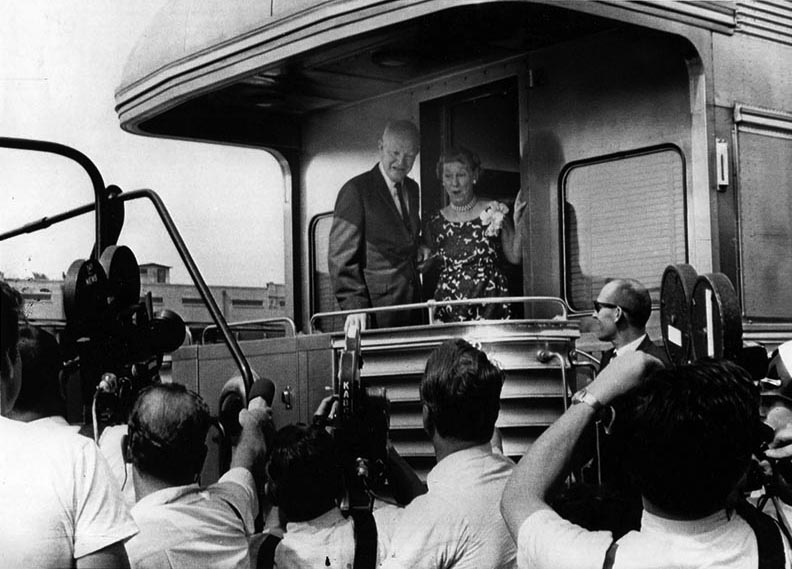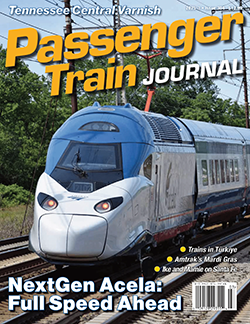 by Jonathan Boyle, Sr./photos as noted
by Jonathan Boyle, Sr./photos as noted
The departure of President and Mrs. Dwight D. after serving two terms, brought to a close some defining chapters of U.S history. They were the last presidential couple to have been born in the 19th century, and “Ike” was also the last chief executive to make extensive use of campaign trains. His Eisenhower Special — with its drum-head sign coaxing citizens to “Look Ahead, Neighbor!” — no doubt was instrumental in bringing the former “non-politician” to victory in 1952.
Campaigning by train played a much smaller role four years later. Mamie’s popularity and endearing personal manner in engaging the public, both on and off the campaign trail, was well known, and some political pundits claimed her contribution to the ticket was worth 50 electoral votes. He chose to be known as General Eisenhower after leaving office, and Americans would always recall his stellar military career, culminating in his World War II role as Supreme Commander of the Allied Expeditionary Force in Europe and his guidance in the postwar establishment of NATO, as well as his leadership during eight prosperous and mostly peaceful years as president. Such service to the United States in these multiple roles will likely not be repeated.
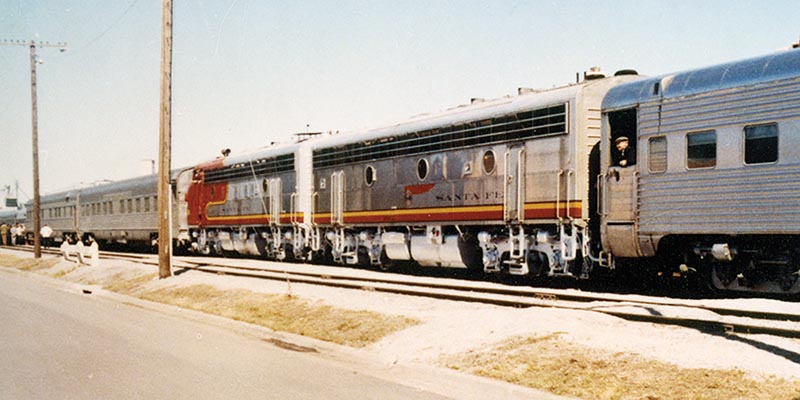
ABOVE: Special train chartered for Dwight and Mamie Eisenhower and their party to ride to Abilene, Kan., for the dedication of the Eisenhower Library on May 1, 1962. Note the unusual mid-train placement of the Santa Fe “Warbonnet” locomotives. —Eisenhower Library and Museum
Although they retired to their farm in Gettysburg, Pa., directly from Washington, D.C., the Eisenhowers had many friends and varied interests in a number of western states. As early as February 6, 1961, the famous former First Couple embarked on what would be the first of a number of train trips they enjoyed in the post-presidential years. Visits to both of their childhood homes — his in Abilene, Kan., and hers in Denver — plus a favorite winter vacation spot near Palm Springs, Calif., frequently made extensive, but not exclusive, use of Atchison, Topeka & Santa Fe (AT&SF) for their travels by rail.
Always well-known for providing its passengers with a smooth ride, meticulous service, and superb cuisine and equipment, Santa Fe was a natural choice of the Eisenhowers for their numerous rail trips, and health concerns made their sojourns by train an attractive travel alternative. Although Ike had embraced the use of official aircraft on presidential business, Mamie did not like to fly. She also avoided Santa Fe’s northern route via Raton Pass in New Mexico due to its high altitude. A rheumatic heart malady sometimes led to their private car being equipped with oxygen, should it be needed en route.
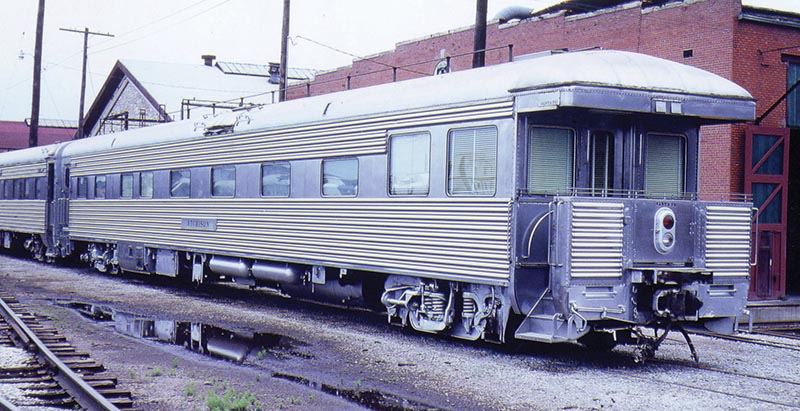
ABOVE: When the author had the opportunity to tour business car Atchison in 1966, he found it equipped with white carpeting and a color television, neither of which were then commonplace, especially on passenger trains. All three of these cars were ultimately equipped with the Pyle Gyralites, which lent an especially striking appearance at night. The Eisenhowers traveled aboard all three cars over the years. —Ron Wagoner; J.J. Boyle, Sr. Collection
Fred G. Gurley, a personal friend of the Eisenhowers, ascended to Santa Fe’s presidency in 1944. The following year, the railway acquired the first of three business cars that would ultimately be named Santa Fe. The first, a 1927-built heavyweight Pullman product, was originally privately owned and named Edgewood. Four years after its acquisition by AT&SF, the car yielded its name (afterward simply numbered as car 40) to the first of three lightweight, open-platform business cars the company would ultimately own.
In 1949, Pullman-Standard delivered the second executive car to bear the name Santa Fe. President Gurley at some point made this private car (primarily designated for his use) available for Ike and Mamie’s journeys. In the same year as Gurley’s retirement as president, 1957, the Budd Co. delivered the railway’s final two lightweight, open-platform business cars. Again, one of the cars would assume, for the final time, the name Santa Fe. The 1949 P-S car then became the Atchison. The third Santa Fe and the Topeka were delivered by Budd as identical cars, 87.5 ft. in length and equipped with six-wheel trucks (later replaced with four-wheel trucks). Their 1949 P-S predecessor was 85 ft. long, and was built with four-wheel trucks. Throughout their long, happy association with AT&SF, Ike and Mamie traveled aboard all three of these cars, which continued to be made available under the Santa Fe presidencies of Ernest S. Marsh and John S. Reed.
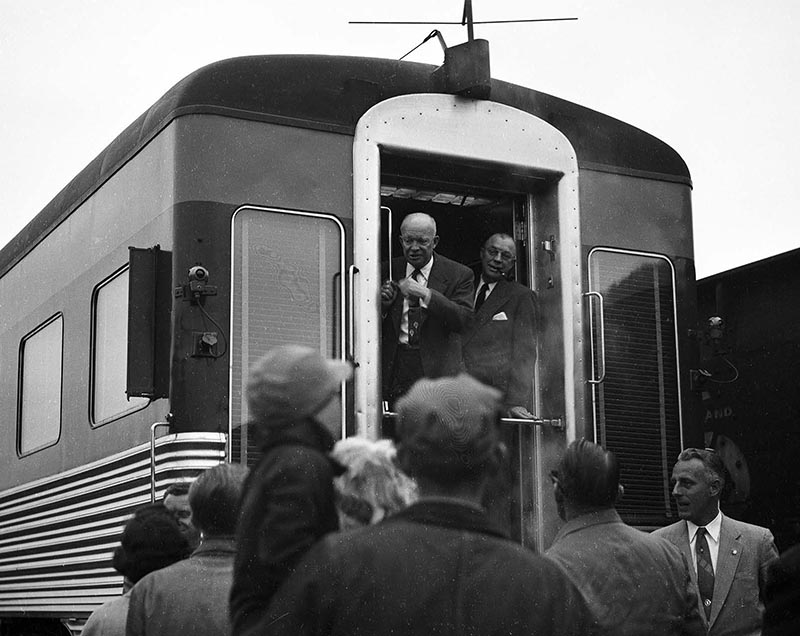
ABOVE: President Eisenhower was joined at the rear door of Chesapeake & Ohio business car Chessie 29 by his brother Milton. Assigned to C&O President Walter J. Tuohy, this car had been rebuilt from blunt-end P-S sleeper-lounge-observation car New River Club. Ike appears to be making some impromptu remarks to a crowd at Clifton Forge, Va., on March 28, 1956, following a meeting with Canada’s prime minister and Mexico’s president at C&O’s Greenbrier hotel in nearby White Sulphur Springs, W.Va. —C&O Historical Society, cohs2243
When the Eisenhowers planned a westbound rail journey, the request was made and often the newest Santa Fe was forwarded over Pennsylvania Railroad to Harrisburg, Pa., the most convenient stop for them to board. Transferred to AT&SF home rails in Chicago, the car could be seen spotted at one of the bumper posts in Dearborn Station. The general could occasionally be found on the rear platform and sometimes waved to onlookers as the train followed its route. An additional sleeper was assigned along with the business car to provide accommodations for the general’s retinue.
Santa Fe proved to be a most accommodating host and offered a number of courtesies in several ways. In a 2005 interview with the author, former AT&SF President John S. Reed recalled that a special reading light was installed in the bedroom used by Ike aboard the Santa Fe so he could enjoy reading Western novels before retiring for the evening. Reed said the light remained all those years later, and that the fixture was the only way the two 1957-built cars’ interiors differed. Excellent dining was another expected railroad tradition, and a singular breakfast treat enjoyed on the car was a favorite dish called “Georgia Ice Cream.” The special concoction, prepared expressly for the general’s enjoyment, featured quail hash served over grits…


